Whether or not you live in the tropics, give your garden a dose of jungle style with a flamboyant flowering vine. These climbers are known for their exuberance but can be kept garden-size if trained on a fence or an arbor. Whether you’d like to trail a fragrant vine over a trellis or surround your patio with foliage and flowers, take a look at these eight showy vines that thrive in temperate gardens.
Love Lavender? Use It Indoors Too
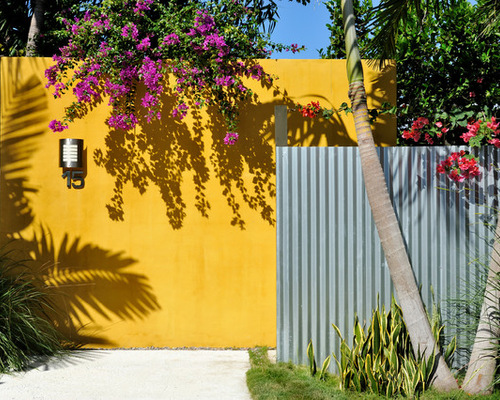

Bougainvillea, original photo on Houzz
1. Bougainvillea
(Bougainvillea spp.)
These hot-colored South American natives thrive in spots where many other plants would fail, such as in poor soil or exposed to radiant heat along a south-facing wall. Use them to add a generous dose of vibrant pink, red, purple or pearly white to Mediterranean- and tropical-style backyards. All bougainvilleas are frost-tender; plant them in pots and bring them to a sheltered location to overwinter, or when temperatures dip below freezing.
Where it will grow: Hardy to 30 degrees Fahrenheit, or minus 1.1 degrees Celsius (USDA zones 9 to 11; find your zone); can be grown in a container and taken indoors during winter in Zone 8 and below
Water requirement: Moderate; low once established
Light requirement: Full sun to light shade
Mature size: 15 to 30 feet tall and 10 to 20 feet wide
Learn more about growing bougainvillea
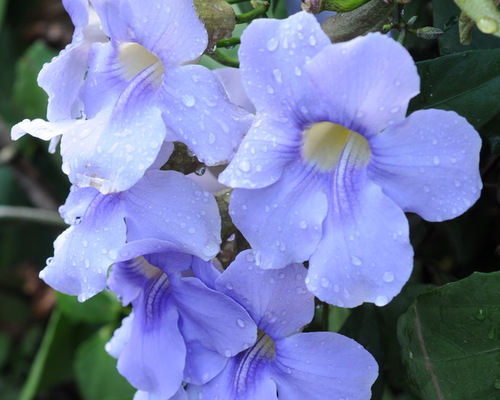

Lidia Zitara, original photo on Houzz
2. Sky Flower
(Thunbergia grandiflora)
Native to northern India, sky flower (also called Bengal clock vine or Bengal trumpet) is one of those stop-you-in-your-tracks vines. The nodding, trumpet-like flowers span 3 inches, with yellow throats and vibrant lavender-blue petals. The flowers attract hummingbirds as well as bees and butterflies, and stand out against the large dark green leaves and rope-like stems. Train a sky flower vine over an arbor to create a dramatic entrance to the garden.
Where it will grow: Hardy to 15 degrees Fahrenheit, or minus 9.4 degrees Celsius (zones 8 to 11)
Water requirement: Moderate
Light requirement: Full sun to partial shade
Mature size: 15 to 30 feet tall and 10 to 20 feet wide
3. Mandevilla
(Mandevilla spp.)
A popular choice for training on trellises or planting to spill out of containers, mandevilla vines come in all sizes and a rainbow of colors. Choose varieties with different flower colors — such as lilac, pink and dark red — to create a wash of color along a driveway fence, or plant a dwarf hybrid to trail down from a hanging basket.
Caution: All parts of this plant are poisonous.
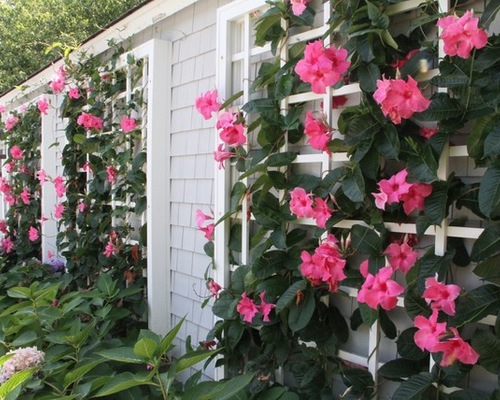

Borab Landscape Inc, original photo on Houzz
Chilean jasmine (M. axa) is more cold-hardy than the typical red- and pink-flowering mandevilla vines, tolerating temperatures down to 10 degrees Fahrenheit, or minus 12.2 degrees Celsius, and is a great option in cooler climates to get a tropical hit. This vine has a lot to offer, with lush, wavy-looking leaves and fragrant white flowers that bloom from late spring through summer. Train to cover a free-standing trellis as a sweetly scented screen, or allow it to cover a wall behind a seating area to enjoy the fragrance.
Where it will grow: Generally hardy to 20 degrees Fahrenheit, or minus 6.7 degrees Celsius (zones 9 to 11); grow as an annual elsewhere
Water requirement: Moderate
Light requirement: Full sun to light shade
Mature size: Varies by species and hybrids; large vines can reach 10 to 20 feet tall and wide, while dwarf hybrids can stay as compact as 18 inches tall and 24 inches wide
4. Honeysuckle
(Lonicera spp.)
These fast-growing climbers are excellent vines for quickly covering a pergola or the walls of an enclosed courtyard. The blossom colors range from creamy white and pale yellow to hot coral and fiery red-orange; all are favorites of hummingbirds.
Coral honeysuckle (L. sempervirens), shown here, is native to the East Coast from Connecticut west to Ohio and Oklahoma, and south to Florida and Texas.
Attract More Wildlife to the Garden With a New Bird Bath
Some varieties, such as purple-leaf Japanese honeysuckle (L. japonica ‘Purpurea’), have reddish stems and leaves with a plum-tinted underside. Japanese honeysuckle and other honeysuckles are considered invasive in some areas. It’s best to check with a local nursery before bringing any into your garden, and do not plant close to open space.
Where it will grow: Hardiness varies by species; many range from minus 25 degrees Fahrenheit, or minus 31.7 degrees Celsius, to 25 degrees Fahrenheit, or minus 3.9 degrees Celsius (zones 4 to 9).
Water requirement: Moderate
Light requirement: Full sun to light shade
Mature size: Varies by species; many are more than 20 feet tall and wide
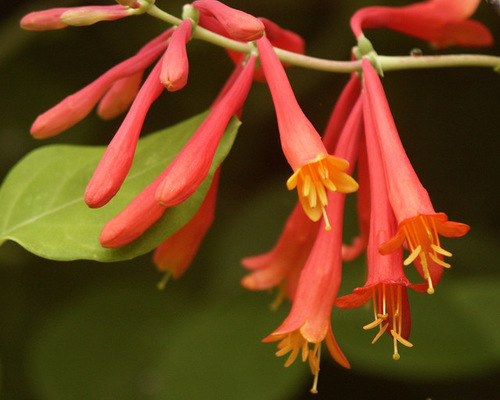

Ellen Sousa/Turkey Hill Brook Farm, original photo on Houzz
5. Passionflower
(Passiflora spp.)
Perhaps the most distinctly tropical-looking vine of the bunch, passionflower offers everything you want (and maybe don’t want) with a flowering vine. Plant a single vine to cover a fence with lush leaves and dramatic blooms. Passionflower is native to Central and South America.
Pros: The stunning exotic flowers will instantly remind you of your warm-weather holiday and are a favorite of bees, butterflies and other pollinators. The plant is also surprisingly cold-hardy.
Cons: The vines can quickly take over. It’s best keep them on a structure where they can be contained with frequent pruning. If your property borders open space, skip planting altogether to avoid their running rampant.
Where it will grow: Hardy to minus 5 degrees Fahrenheit, or minus 20.6 degrees Celsius (zones 6 to 9)
Water requirement: Moderate
Light requirement: Full sun to partial shade
Mature size: 15 to 40 feet tall and wide
6. Confederate Jasmine
(Trachelospermum jasminoides)
A favorite climber for covering fences and trellises, confederate jasmine, also called star jasmine, has glossy dark green leaves and fragrant white flowers. The vines grow quickly — a single plant can cover a 6-foot section of fence in one season. Confederate jasmine is evergreen in mild climates. Despite what may be suggested by the common name, confederate jasmine is native to China and Japan.
Caution: Toxic if ingested by dogs but nontoxic to cats.
Where it will grow: Hardy to 10 degrees Fahrenheit, or minus 12.2 degrees Celsius (zones 8 to 11)
Water requirement: Moderate; regular water in hot climates
Light requirement: Full sun to light shade
Mature size: 18 to 20 feet tall and wide, or 1 foot to 2 feet tall as a trailing ground cover
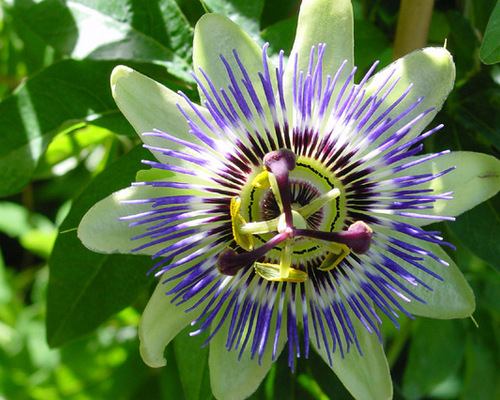

Dig Your Garden Landscape Design, original photo on Houzz
7. Cape Honeysuckle
(Tecomaria capensis)
This vine-like South African native has clusters of red-orange tubular flowers that bloom in fall and winter, when most other flowering vines are past their peak. The flowers are rich in nectar, providing a steady source for pollinators throughout the cooler months.
The plants grow upright to 8 to 10 feet tall, but their sprawling growth habit means they need support from a fence or trellis. The branches root where they touch the ground — keep the plants trimmed back to avoid spreading.
Where it will grow: Hardy to 25 degrees Fahrenheit, or minus 3.9 degrees Celsius (zones 9 to 11)
Water requirement: Moderate; low once established
Light requirement: Full sun
Mature size: 8 to 10 feet tall, with vining stems reaching 15 to 20 feet wide
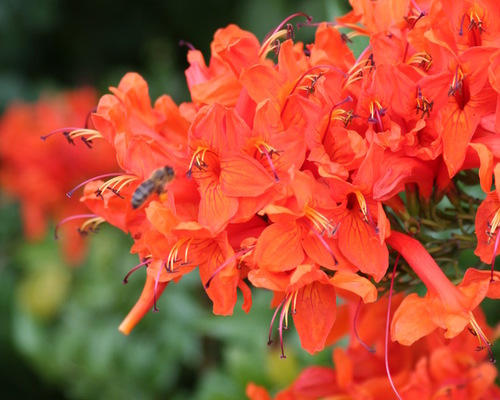

Cape Honeysuckle, original photo on Houzz
8. Madagascar Jasmine
(Stephanotis floribunda syn. Marsdenia floribunda)
Topping the charts for fragrance is Madagascar jasmine, also called bridal bouquet. Just one vine planted over a shade structure would perfume an outdoor seating area with a fresh, jasmine-like smell. Tubular white flowers are held in perfect, bouquet-like clusters (hence one of the common names) and make excellent cut flowers. Native to the rainforests of Madagascar, the plant thrives in humid climates or with frequent misting. Water regularly during the growing season but scale back in winter.
Where it will grow: Hardy to 55 degrees Fahrenheit, or 12.8 degrees Celsius (Zone 12); grow as a houseplant in colder climates
Water requirement: Moderate; low water in winter
Light requirement: Full sun to partial shade in hot inland areas
Mature size: 12 to 20 feet tall and 3 to 6 feet wide; much smaller if grown indoors
10 Reasons to Use a Trellis in Your Yard
If you’re looking for plants for inside your house instead, check out this ultimate guide to houseplants.


